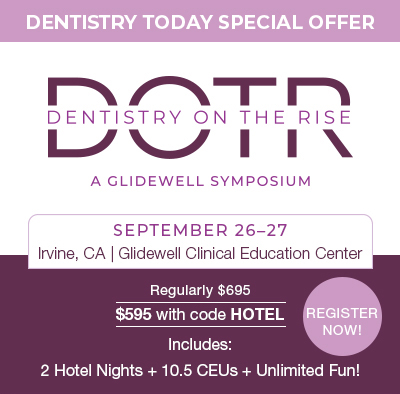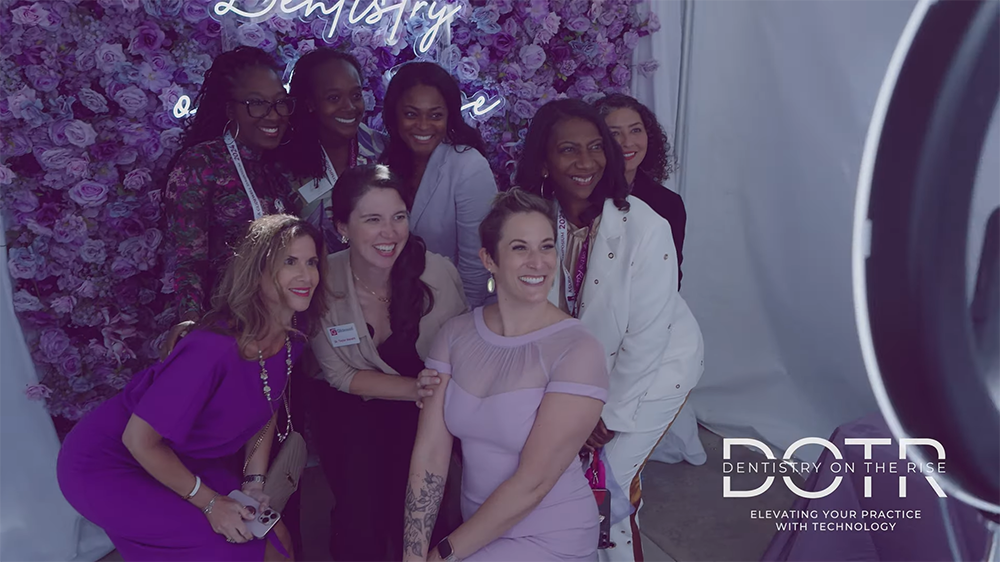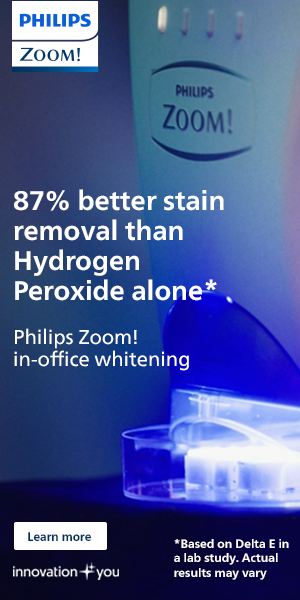A Minimally Invasive Approach to Class III Restorations
Written by: Richard Young, DDS
INTRODUCTION
Restorative dentistry demands precision and creativity to meet functional and aesthetic goals. For older patients, these objectives often intersect with the need for minimally invasive approaches that preserve tooth structure and maintain oral health. This case exemplifies how contemporary materials and techniques streamline the restorative process while exceeding patient expectations.
This 73-year-old male patient sought treatment for chipped incisors on teeth Nos. 8 and 9 (Figure 1). Using the Bioclear BT Matrix and advanced materials from Kuraray America, the treatment plan addressed his primary concerns while achieving an unanticipated yet welcome outcome: closure of a black triangle. This case demonstrates how effective planning and execution can deliver outstanding results for the patient and clinician.

Case Presentation and Treatment Objectives
The patient presented with chipped incisal edges on teeth Nos. 8 and 9. Examination revealed 2 failing composite restorations on the lingual surfaces of these teeth, compounded by minor decay and marginal breakdown. While the patient was unaware of a black triangle between the teeth, addressing this defect was incorporated into the plan as a secondary benefit.
TREATMENT GOALS
1. Restore the chipped incisal edges and replace failing lingual restorations.
2. Close the black triangle to enhance aesthetics and periodontal health.
3. Use a minimally invasive approach to preserve healthy tooth structure.
MATERIALS AND METHODS
Step 1: Preparation
Following local anesthesia with 2% lidocaine (1:100,000 epinephrine), an IsoDam medium non-latex dental dam was placed to isolate the operative field. This prevented contamination and improved visibility. The decayed and failing composite materials were removed using a Komet No. 2 Red Stripe finishing diamond, ensuring preservation of sound tooth structure (Figure 2). Residual decay was eliminated with a Komet No. 2 slow-speed carbide bur, and small bevels were created on the lingual and incisal edges using a Komet 8833 031 Red Stripe diamond. These bevels facilitated better bonding and a seamless restoration.

Step 2: Matrix Placement
The Bioclear BT Matrix System was chosen for its ability to create ideal contours and address black triangles. Using the kit’s measuring tool, the Burgundy (small) Bioclear BT Matrix was selected for teeth Nos. 8 and 9. The matrices were inserted into the periodontal ligament space, extending slightly beyond the gingival margins (Figure 3). By warming the matrix, it adapted well to the teeth, ensuring precise placement.

Step 3: Bonding
- Etching: A total-etch technique was employed. A 37% phosphoric acid etchant was applied for 15 seconds, followed by thorough rinsing and gentle air-drying to maintain slight dentin moisture (Figure 4).

- Adhesive Application: CLEARFIL Universal Bond Quick 2 (Kuraray America) was applied to all etched surfaces using a micro brush. Agitation for 3 seconds ensured thorough application, followed by light air thinning to remove excess solvent. The adhesive was light cured for 10 seconds using an LED curing light.
Step 4: Injection Molding
- Composite Selection: CLEARFIL MAJESTY ES Flow Universal (Kuraray America) was warmed to optimize flow properties. A layer of uncured CLEARFIL Universal Bond Quick 2 (Kuraray America) was applied as a surfactant to enhance composite adaptation.
- Technique: The composite was injected from the lingual side, filling the Class III defects and progressing to the black triangle and incisal edges. This single-step approach allowed the composite to flow seamlessly within the matrix.
- Curing: Light curing was performed for 20 seconds each from the lingual and facial aspects to ensure complete polymerization. The matrices were then carefully removed using hemostats, and the restorations were then ready to be finished and polished (Figure 5).

Step 5: Finishing and Polishing
- Initial shaping was performed with 3M Sof-Lex coarse discs (Solventum).
- Polishing progressed through medium, fine, and super-fine grits, creating a smooth, natural finish. Interproximal areas were refined using polishing strips, and the final luster was achieved with a composite polishing paste.
Step 6: Occlusal Adjustment
After removing the dental dam, the occlusion was checked using articulating paper. Minor adjustments were made with fine grit finishing burs, followed by re-polishing.
CLINICAL OUTCOME
The procedure achieved all treatment goals:
- Restoration of chipped incisal edges and failing lingual restorations.
- Closure of the black triangle, enhancing smile aesthetics.
- Preservation of healthy tooth structure through minimally invasive techniques.
Patient Satisfaction
The patient was delighted with the unexpected closure of the black triangle, which improved the appearance and function of his smile. He expressed increased confidence and comfort, noting that the restorations felt smooth and natural.
DISCUSSION
The Importance of Minimally Invasive Techniques
Minimally invasive dentistry emphasizes the preservation of natural tooth structure while delivering restorative solutions that align with biomimetic principles. Techniques such as beveling and injection molding allow clinicians to achieve strong bonds and seamless transitions without compromising the underlying tooth. The Bioclear Matrix system, described by Clark and Sheets,1 represents a paradigm shift in this approach, offering predictable contours and emergence profiles while addressing aesthetic and functional needs.
Closing Black Triangles
Addressing black triangles conservatively is a significant achievement in restorative dentistry. Traditional options, such as orthodontics or porcelain veneers, often involve substantial intervention. The BT Matrix System simplifies this process by reshaping gingival embrasures with direct composite additions. Studies, including those by Jenkins and Killian,2 have shown that closing black triangles can dramatically enhance patient satisfaction with minimal invasiveness.
Material Advancements
Advancements in restorative materials underpin the success of modern techniques:
- Flowable Composites: CLEARFIL MAJESTY ES Flow Universal exemplifies the new generation of composites designed for injection molding. As van Dijken and Pallesen3 demonstrated, these materials deliver mechanical strength and longevity while simplifying application.
- Universal Adhesives: The evolution of universal adhesives, such as CLEARFIL Universal Bond Quick 2, allows for flexible bonding approaches. Research by Peumans et al4 highlights the reliability of these adhesives across varying etching techniques and substrates.
CONCLUSION
This case illustrates how innovative techniques and materials can simplify complex restorative challenges while delivering exceptional results (Figures 6 and 7). By utilizing the BT Matrix System and products from Kuraray America, the clinician successfully addressed both the patient’s chief complaint and additional aesthetic concerns. This approach highlights the value of minimally invasive dentistry in enhancing patient satisfaction and promoting long-term oral health.


REFERENCES
1. Clark D, Sheets CG. The Bioclear Matrix: A paradigm shift in restorative dentistry. Dent Today. 2010;29(2):112–5.
2. Jenkins WM, Killian CM. Managing gingival embrasures with direct composite additions: An alternative to invasive treatment options. J Esthet Restor Dent. 2016;28(4):218–27.
3. van Dijken JW, Pallesen U. A randomized controlled three year evaluation of “bulk-filled” posterior resin restorations based on stress decreasing resin technology. Dent Mater. 2014;30(9):e245-51. doi:10.1016/j.dental.2014.05.028
4. Peumans M, De Munck J, Van Landuyt KL, et al. Eight-year clinical evaluation of a 2-step self-etch adhesive with and without selective enamel etching. Dent Mater. 2010;26(12):1176–84. doi:10.1016/j.dental.2010.08.190
ABOUT THE AUTHOR
Dr. Young received his dental training at Loma Linda University School of Dentistry (LLUSD) in 1985. He is an assistant professor of general dentistry at LLUSD where he lectures for and co-directs the D4/IDP dental aesthetics program and also lectures on composite dentistry and veneers for the D2 and D3 operative courses. Dr. Young was a very early adopter of advanced bonding techniques and has acquired a wealth of knowledge and clinical experience in minimally invasive dentistry. He has been using photography in his practice for 40 years. He is known for his expertise in digital photography and has inspired countless colleagues to adopt digital photography in their practices. He lectures and gives hands-on workshops internationally on both advanced adhesive dentistry (biomimetic dentistry), innovative injection molding techniques for composite, and digital photography. Dr. Young maintains a private practice with his wife in San Bernardino, Calif, focusing on aesthetic dentistry and minimillay invasive dentistry. He can be reached at ryoungdds@proton.me.
Disclosure: Dr. Young received honoraria from Kuraray America and Bioclear.




